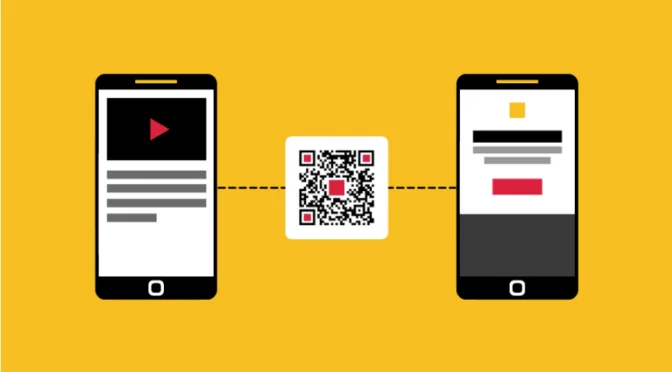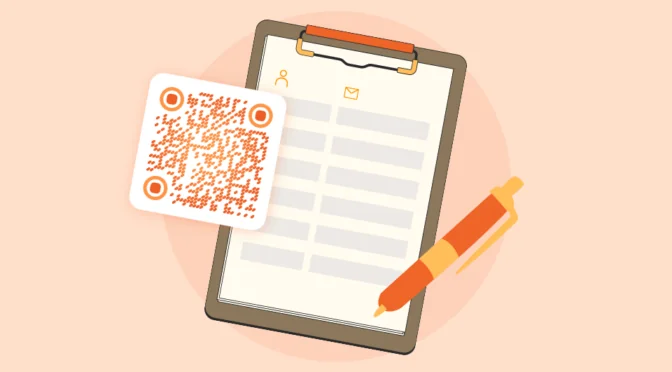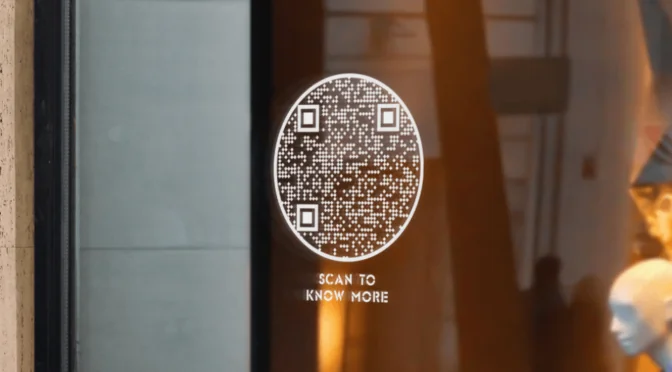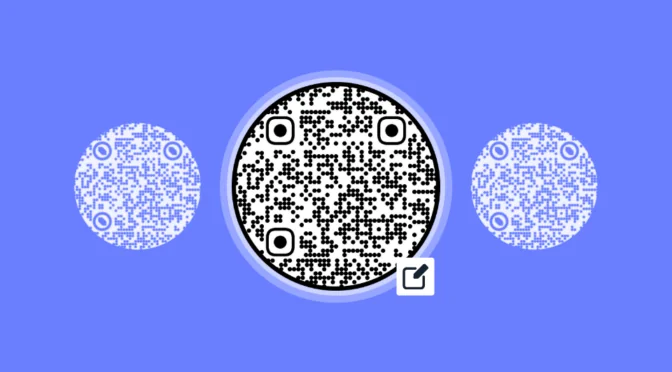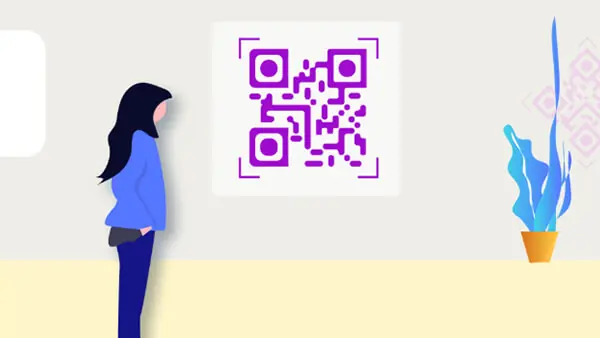💻 Key takeaways:
1. The size of your QR Code will affect how easily it can be scanned. In general, QR Codes should be larger for farther scanning distances.
2. The minimum size for a QR Code is 2x2cm. The maximum size depends on the material you are printing and displaying it on. While resizing QR Codes it’s best to use high-resolution formats such as EPS, and SVG to avoid pixelation.
3. A good rule of thumb is to make your QR Code at least 1 inch (2.5 cm) in size for close scanning (up to 12 inches) and 2 inches (5 cm) or larger for scanning distances beyond 12 inches.
Say you’ve created custom branded QR Codes to be deployed across multiple marketing campaigns. It could be for billboards, TV commercials, banners, or supermarket aisles. Your QR Codes look attractive, have your brand logo at the center, and reflect your brand colors as well. But given that your marketing collateral is of different proportions/sizes, you don’t quite know how to go about QR Code sizing.
You’re in the right place! If you wish to leverage QR Codes in your marketing campaign and are unsure about QR Code size—we have you covered.
This guide will walk you through everything you should know to determine the ideal QR Code size. We will cover the basics of QR Code specifications and how QR Code sizing works. We’ll also dive into some of the specific issues you might face while deploying your QR Codes.
Table of contents
- Does QR Code Size matter?
- A primer on QR Code specifications
- How small can a QR Code be?
- How big can a QR Code be?
- How are QR Code size and module configurations related?
- A QR Code resizing tip
- Resolution requirements for QR Codes
- Determining QR Code size in relation to scanning distance
- Typical QR Code sizes for different marketing use cases
- Apple’s iOS 14 update and QR Codes
- Other optimizations whilst considering QR Code size
Does QR Code size matter? Yes.

QR Code size does matter—and overlooking this can cost you a lot of scans. This is because QR Code size correlates with scannability.
Even if users want to scan your codes, the QR Code size might hinder them from doing so. The combination of size and scanning distance in particular instances can even render your QR Codes unreadable.
Getting QR Code size right will ensure easy scannability, regardless of where you plan to deploy them.
A primer on QR Code specifications

Simply put, QR Codes are 2D versions of barcodes.
A simple black-and-white QR Code consists of many tiny black and white squares that form patterns so that information can be embedded within it. Each of these squares, which can be in other contrasting colors apart from black and white, is called a ‘module’.
The module size refers to the individual squares (modules) that make up the QR Code. Larger module sizes increase the overall size of the QR Code but may enhance scanability, especially in low-resolution or low-contrast environments.
The earliest version (Version 1) of a QR Code comprised a 21 x 21 module configuration, i.e, 21 modules along two directions. Version 2 comprised a 25 x 25 module configuration, Version 3 was 29 x 29 modules, and Version 4, 33 x 33 modules. With each new version, there has been an addition of 4 modules horizontally and vertically.
The latest QR Code type is Version 40 with a 177 x 177 configuration—a total of 31,329 modules. This is the maximum number of modules that can be used in QR Codes today. Higher versions accommodate more data but result in larger QR Codes.
Depending on the amount of data to be encoded and the character type (alphanumeric, binary, Kanji, etc) more modules are required, and therefore a bigger size. The amount of data encoded in the QR Code affects its size. More data requires a larger QR Code, while less data allows for smaller sizes.
The encoding mode used in the QR Code (numeric, alphanumeric, byte, or kanji) can also affect its size. Different encoding modes have different size requirements for encoding the same data.
How small can a QR Code be?
While there is no fixed minimum size for QR Codes, 1 cm x 1 cm is a good baseline for most close proximity use cases. In pixels, this QR Code size will approximately be a resolution of 38 x 38 px.
We recommended that you choose your QR Code dimensions well above the smallest possible size so that they can be easily scanned by smartphone cameras. In addition, they have to be big enough to showcase any custom visual elements that may attract people to scan.
How big can a QR Code be?
In theory, QR Codes can be as big/small as you’d like them to be. There is no maximum or minimum possible QR Code size. But, again, if you want your QR Codes to be as small as possible, we recommend a 1 cm x 1 cm size. This ensures that they occupy the least possible space while also being scannable for users.
However, in terms of modules (and not the final size which can be altered by stretching and rescaling), there are the minimum and maximum configurations. Currently, the minimum configuration is 11 x 11 modules and the maximum is 171 x 171 modules respectively.
How are QR Code size and QR Code module configurations related?

The smallest unit of a QR Code is a module. It is essential for any QR Code scanner software (be it an external device or your camera app) to be able to discern each module clearly.
With more modules horizontally/vertically, the QR Code size should be bigger so that scanning each module is easy. For instance, if you have a 177 x 177 module QR Code with a really small size, telling modules apart to understand the encoded pattern becomes extremely difficult.
Alternatively, if you want an 11 x 11 module QR Code (the smallest possible configuration) in an enlarged form, you’d have to resize it. This is because the individual size of the modules themselves might be too small. Resizing then is tricky—enlarging can make the QR Code modules stretched or blurred leading to poor scannability.
Therefore, QR Code size and the QR Code module configuration affect each other—getting them accurate is important.
Fortunately, Uniqode’s paid QR Code solution takes care of this for you. We automatically choose the module configuration based on different factors involved like data size, the extent of customization, error correction, etc. We also provide an option to choose a custom size from within the platform itself!
A QR Code resizing tip: Use the SVG format to resize your QR Codes!
If you have created a custom QR Code for print and wish to resize it for different campaign purposes, use the SVG format.
The advantage of Scalar-Vector-Graphics is that QR Codes in the SVG format can be scaled to any size — without compromising on quality. This means there won’t be any pixelation or stretching of modules. You can repurpose the same QR Code on different materials like billboards, banner design templates, flyers, poster templates, TV commercials, etc in different sizes.
For QR Code resizing, downloading them in the SVG format is the way to go. Only paid QR Code solutions allow you to do this!
Resolution requirements For QR Codes
QR Codes should be generated at an appropriate resolution to ensure clarity and sharpness, especially when printed in larger sizes.
If you’re not sure about what resolution your QR Code should be, the 38 x 38 px configuration for a 1 cm x 1 cm QR Code is a good starting point.
In this case, 1 cm is approximately equal to 38 pixels. So, the resolution required for any QR Code to be reliably read is 38 x 38 pixels. Again, size varies depending on the specific use case —but this is a rough minimum guideline to work with.
Determining QR Code size in relation to scanning distance

The intended viewing distance of the QR Code should be considered when determining its size. Larger QR Codes may be necessary for viewing from a distance, while smaller ones may suffice for close-range scanning.
The rule of thumb to follow for the ideal QR Code size is a 10:1 distance-to-size ratio. This means that the QR Code size should be 1/10th of the distance where users scan it from. Depending on the specific use case, consider the distance from which end-users will view the QR Code. You can then adjust the size accordingly using this formula:
QR Code Size (width/length) = Scanning Distance/10
Typical QR Code sizes for different marketing use cases

The intended application of the QR Code (e.g., packaging, signage, business cards, or digital screens) may influence the optimal size. QR Codes for larger surfaces may require larger sizes for readability, while those for smaller surfaces may need to be more compact.
Considering the 10:1 distance-to-size ratio for QR Codes, we have compiled this quick reference guide for various QR Code use cases:
| QR Code use case | Typical scanning distance | Typical QR Code size |
| Product packaging, business cards | 10-15 cm | 1 cm – 1.5 cm |
| Magazines, newspapers, catalogs, flyers | 40 cm – 70 cm | 4 cm – 7 cm |
| Signages, wall posters, product stands | 100 cm – 250 cm | 10 cm – 25 cm |
| TV commercials | 225 cm – 600 cm | 22.5 cm – 60 cm |
| Billboards | 750 cm – 1500 cm | 75 cm – 150 cm |
Improvements in QR Code scanning capabilities with the iOS 14 update

New feature improvements rolled out with Apple’s iOS 14 update include better native QR Code scanning capability. According to Apple’s official website, iPhones can now —
- Natively detect smaller QR Codes easily with the camera app
- Scan QR Codes wrapped around objects
This is important to consider while determining the size of your QR Codes. Given that scanning capabilities are improving, marketers can deploy smaller QR Codes if there are tight space constraints.
Other optimizations while considering QR Code size
Ensuring a QR Code quiet zone

‘Quiet zone’ is the blank space left around a QR Code in order to differentiate it from other design elements. Smartphone cameras/QR Code readers have to identify clearly where the QR Code is on the marketing material. White spacing does precisely this by providing a buffer zone between the QR Code and other design components.
QR Codes require a quiet zone (blank space) around them to ensure accurate scanning. The size of the quiet zone is typically proportional to the size of the QR Code itself.
To ensure easy scannability without any mix-up, a white space margin that is 4X the module size is preferred.
Shortening URLs wherever possible

As a rule of thumb, if more data has to be embedded in a QR Code, more modules are required. For the same printing area, greater the number of modules, greater will be the appearance of density. This means that the QR Code will look like it’s tightly packed together, compromising on readability.
It’s ideal to shorten URLs and other encoded content as much as you can. Less QR Code data means that the total number of modules required will be fewer. If you’re restricted by the space allowed for the QR Code in the design, stick to a lower module configuration.
Setting lower error correction levels for size constraints

Error correction in QR Codes is a way to retrieve data if there is any damage due to wear and tear. There are four error correction options that you can choose from:
Level L: 7% of data can be restored.
Level M: 15% of data can be restored.
Level Q: 25% of data can be restored.
Level H: 30% of data can be restored.
While it’s ideal to have as much error correction as possible, higher levels require more modules. Larger module configurations, as we have seen, require a larger area/QR Code size for better scannability. If there are severe size constraints, choosing Level L, where only 7% of the data is retrievable, is ideal.
That’s about it—we hope this guide gave you all the information you need to size your QR Codes! If you require dynamic QR Codes for print material, packaging, billboards, TV commercials, and more, check out our paid QR Code solution here.








